Text
Hey All,
I've been away for some time, as we've been working really hard on something quite exciting:
let me present to you the world's first ever global ocean drainage basin map that shows all permanent and temporary water flows on the planet.

This is quite big news, as far as I know this has never been done before. There are hundreds of hours of work in it (with the data + manual work as well) and it's quite a relief that they are all finished now.
But what is an ocean drainage basin map, I hear most of you asking? A couple of years ago I tried to find a map that shows which ocean does each of the world's rivers end up in. I was a bit surprised to see there is no map like that, so I just decided I'll make it myself - as usual :) Well, after realizing all the technical difficulties, I wasn't so surprised any more that it didn't exist. So yeah, it was quite a challenge but I am very happy with the result.
In addition to the global map I've created a set of 43 maps for different countries, states and continents, four versions for each: maps with white and black background, and a version for both with coloured oceans (aka polygons). Here's the global map with polygons:
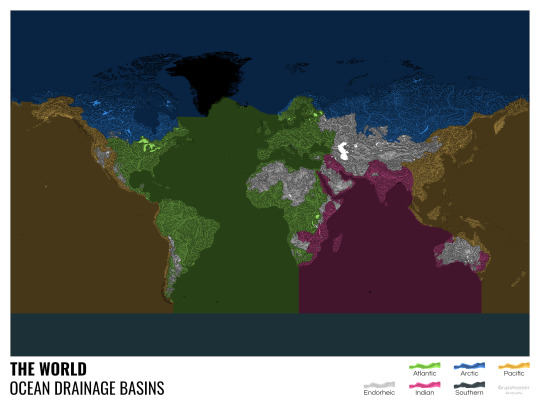
I know from experience that maps can be great conversation starters, and I aim to make maps that are visually striking and can effectively deliver a message. With these ocean drainage basin maps the most important part was to make them easily understandable, so after you have seen one, the others all become effortless to interpret as well. Let me know how I did, I really appreciate any and all kinds of feedback.
Here are a few more from the set, I hope you too learn something new from them. I certainly did, and I am a geographer.
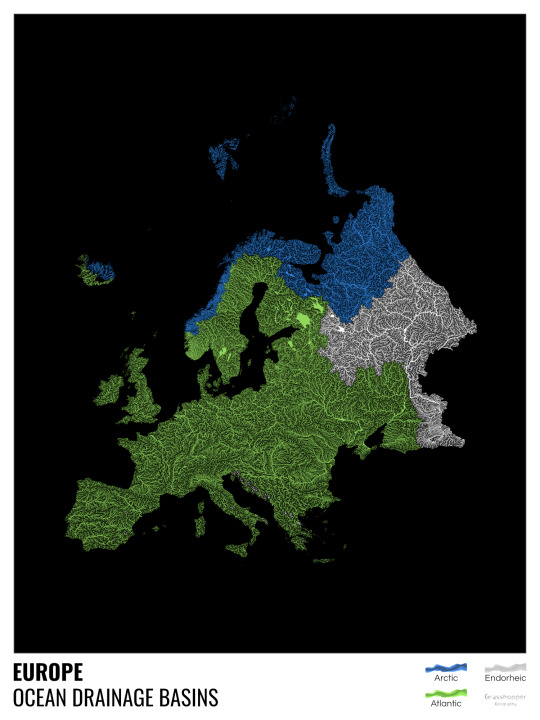
The greatest surprise with Europe is that its biggest river is all grey, as the Volga flows into the Caspian sea, therefore its basin counts as endorheic.
An endorheic basin is one which never reaches the ocean, mostly because it dries out in desert areas or ends up in lakes with no outflow. The biggest endorheic basin is the Caspian’s, but the area of the Great Basin in the US is also a good example of endorheic basins.
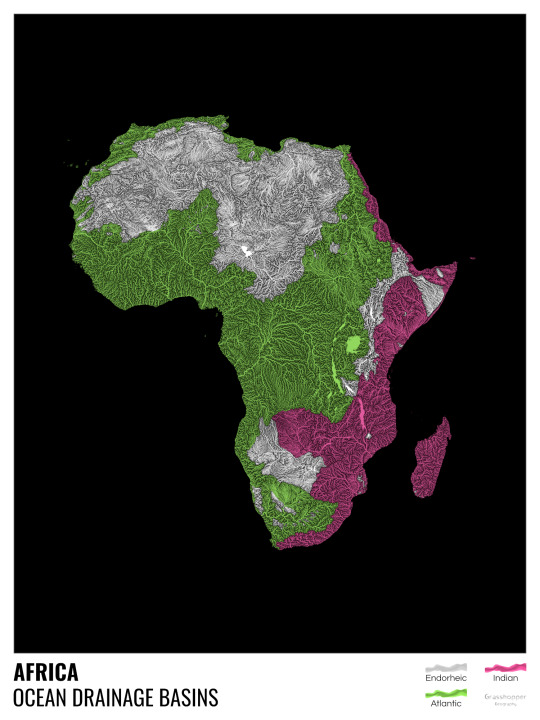
I love how the green of the Atlantic Ocean tangles together in the middle.
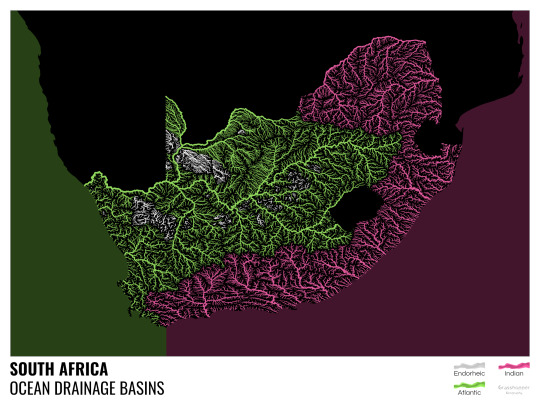
No, the dividing line is not at Cape Town, unfortunately.

I know these two colours weren’t the best choice for colourblind people and I sincerely apologize for that. I’ve been planning to make colourblind-friendly versions of my maps for ages now – still not sure when I get there, but I want you to know that it’s just moved up on my todo-list. A lot further up.

Minnesota is quite crazy with all that blue, right? Some other US states that are equally mind-blowing: North Dakota, New Mexico, Colorado, Wyoming. You can check them all out here.
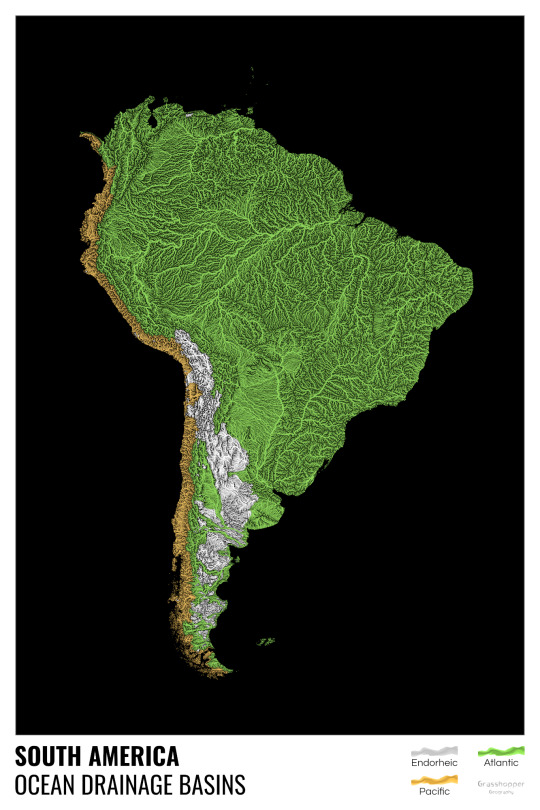
Yes, most of the Peruvian waters drain into the Atlantic Ocean. Here are the maps of Peru, if you want to take a closer look.
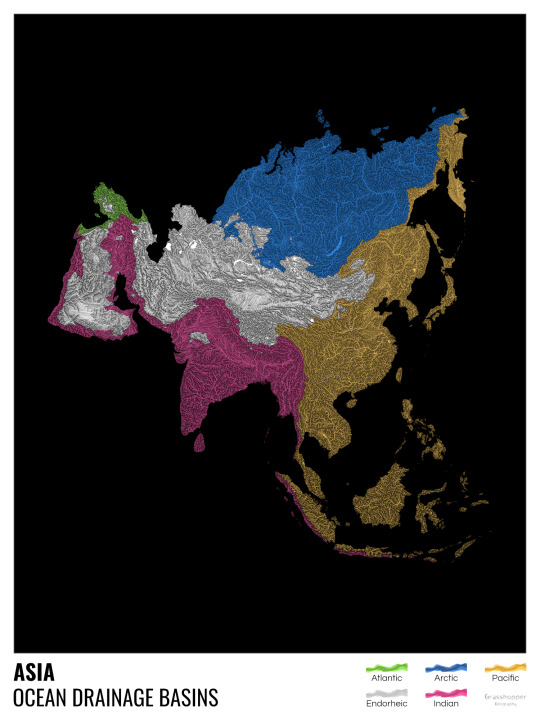
Asia is amazingly colourful with lots of endorheic basins in the middle areas: deserts, the Himalayas and the Caspian sea are to blame. Also note how the Indonesian islands of Java and Sumatra are divided.
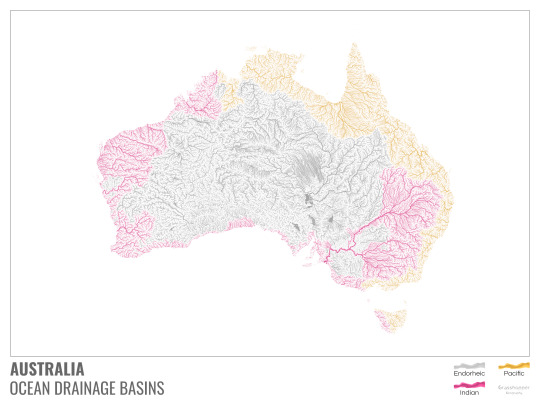
I mentioned earlier that I also made white versions of all maps. Here’s Australia with its vast deserts. If you're wondering about the weird lines in the middle: that’s the Simpson desert with its famous parallel sand dunes.
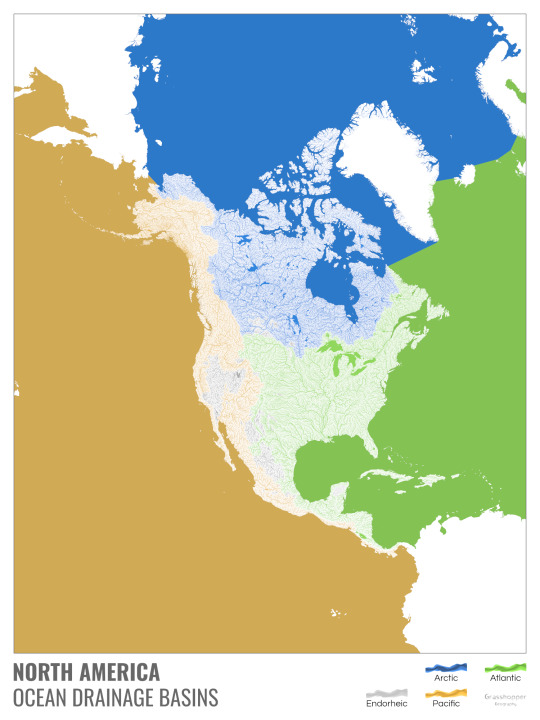
North America with white background and colourful oceans looks pretty neat, I think.

Finally, I made the drainage basin maps of the individual oceans: The Atlantic, the Arctic, the Indian and the Pacific. The Arctic is my favourite one.
I really hope you like my new maps, and that they will become as popular as my river basin maps. Those have already helped dozens of environmental NGOs to illustrate their important messages all around the world. It would be nice if these maps too could find their purpose.
16K notes
·
View notes
Text
Here's a neat example of just how different other planets can be!
103 notes
·
View notes
Text
i think one of the reasons i get mildly annoyed about worldbuilding threads that are 200 tweets of why you should care about where blue dye comes from in your world before saying someone is wearing blue is that so few of them go up to the second level of "and that should impact your characters somehow" - i don't care that blue dye comes from pressing berries that only grow in one kingdom a thousand miles away if people are casually wearing blue
#reblog#details#sartorial#we sometimes unhelpful advice because we don't realize who's building for fun and who's building for a story
28K notes
·
View notes
Text
Submitted via Google Form:
Do you have anything on building a lot of floating structures on the ocean? I'm talking about entire countries consisting of multiple large cities on the ocean. Thousands of miles wide. Would multiple islands work better so it looks like a lagoon but on the ocean or one giant structure? What kind of technology a civilization would need to consider such an undertaking? I'm also debating the main source of power and am trying to figure out if hydro or solar would be better, I'm sure there would be a mix but not sure what might be more advantageous.
Tex: We have answered something similar on this before (Wordpress), and chinampas are a similar idea (Wikipedia).
One of the potential issues with this is that oceans have different divisions that can be classed by amount of sunlight received (Wikipedia), and obstructing the sunlight to large portions of the ocean would interfere with its ecology. This will inevitably have negative effects, and in an ideal situation, masses this big would be on a reasonably steady drift to keep from harming any particular area of the ocean.
Something thousands of miles wide would need to be able to withstand the potential destruction caused by wave height that might or might not be uniform in severity (Wikipedia). Making lots of small, interlocked platforms would help distribute most of the forces caused by wave generation, and would be optimal in terms of energy requirements compared to technologies such as anti-gravity and other forms of propulsion to counteract potential shear forces.
Hydro or solar power would unfortunately be insufficient for the scale you’re looking for, as it would not generate enough power in a short enough amount of time to be routed toward counteracting the forces exerted upon the structures by the ocean itself. You would need to look at a consistent generation of power, as well as several power banks in case of distribution interruptions. Solar, wind, and marine energy are good passive systems that can broker energy gaps in an emergency, but currently the minimum standard would be some form of nuclear power.
An excellent fictional example that you could model would be Stargate’s city of Atlantis (SGCommand). It is a city-ship, in that it is a very large habitable construction designed to float in the ocean and also fly through deep space, and as such a good reference for advanced technological applications like what you’re attempting.
16 notes
·
View notes
Note
hello! i'm currently building a world for a wild west themed ttrpg. the continent the game takes place in is a desert that's been cursed to be isolated from the rest of the world—no one can go in, no one can go out. anyone that tries to escape finds themselves lost in an endless expanse of sand. but i digress, anyways! the main issue of this continent (isolation aside) is the fact that it has no access to water at all. how people hydrate is through this fruit which has a liquid inside that the people can drink. think of a coconut but it can grow properly in a desert since it's magic.
i'd just like to know if there's any sort of worldbuilding advice or questions that could help me explore this idea in a more meaningful way? i already have some of the logistics of how this sort of thing could be distributed in a world like this but i want it to be more grounded. magic exists in this world so that can help explain some things but i want to be careful not to make it so wishy-washy, y'know? thanks so much!
Tex: Even the largest of deserts have an end, be it another biome or a body of water because the continent can only be so large across a planet. Aside from that, clouds will not inherently respect anyone’s boundary on where they can move as part of the water cycle and the natural unevenness of terrain means that water will eventually pool up somewhere, creating oases.
Mountains, perhaps, may slow the movement of humidity in the air, but unless you’re willing to make a very, very, very large volcano that’s dead enough and large enough to accumulate sand (which in that instance would be more akin to volcanic ash and as sharp as ground glass), water will still naturally get in and settle into bodies of water.
Accordingly, the “wild west” only existed because of the rapid development of trains and railroad lines, so even historically they were not actually isolated - merely delayed, in terms of what they were able to ship. By 1900, someone could travel from the East Coast of the US to the West Coast in approximately a week, depending on the route. If fresh food is packed well (say, seafood in ice), it wouldn’t even spoil for the duration of that journey.
For desert flora that can act as reservoirs of water, the Saguaro cactus is a very good example of this (Wikipedia), as are many types of melons (Wikipedia).
Feral: The biggest concern historically, including during the Wild West, in desert climates was not getting hydration for the people but for the horses. Horses drink 5 to 10 gallons (20 to 40 liters) of water a day. Humans need 0.5 to 0.8 gallons (2-3 liters). Although humans/player characters of whichever races you’re using can probably get by with the sources of hydration Tex mentioned, but if they have mounts, there’s going to be a problem. With a ttrpg, this could just be flavor or it could be an actual resource mechanic. To make it more on the believable side, I would recommend wells being a thing. Maybe in towns or along common routes. Also keep in mind, fruits that provide hydration do not spontaneously create water; they absorb it, so there must be water somewhere, somehow.
Wootzel: If this magic fruit is legitimately the only source of drinkable water, does that also apply to whatever other plants that grow? Are all animals in this area dependent on the fruit as well? Are people having to break the fruits over their crops?
I’m taking a wild guesstimation that if EVERYTHING that needs water has to get it via this fruit because there’s almost no ground water and no precipitation, then 80% or more of the plants growing in this area are the plant that bears this fruit. Or can other plants draw water from the ground in some way (but is it not accessible via digging or drilling a well or whatever because magic curse?), and it’s just fauna that have to drink via fruit?
Do the fruits or their liquid spoil easily, or at all? Do they ferment and become alcoholic? Do the local jackrabbits get drunk on them like deer with apples, and stumble around the desert at night?
What else is in the fruit-liquid? Is it just as functional a source of hydration as water, or are there any other substances in it that the body needs to process out… maybe via the kidneys… resulting in needing to drink more of this liquid than one would need to drink water?
Does evaporating this fruit liquid and trapping/condensating the resulting water work well enough if someone needed plain water for wound care, baby care, or whatever else?
How does anyone bathe?
Are many conflicts involving control of these fruit and the plant they grow on, since having that resource cut off is quickly deadly? Meaning, even if the conflict wasn’t originally about fruit-control, someone burns down someone else’s orchard and now that’s the main focus? Or is this stuff so prevalent that you could try to kill it and it just starts growing back from a crazy tap root the next day?
You have a premise that’s not highly plausible, and it would probably make life rough and precarious for the people and animals who live in this area, but it’s not impossible for human ingenuity to figure out how to make it work anyway. If you choose to keep your water-fruit as the only source of hydration, life is going to look QUITE different in this area.
Addy: I've got a couple thoughts, some are more rambly than others. The first question I've got is no water at all vs no water that's suitable for humans. There's a fair amount of difference in what those will imply for plant and animal life.
Most deserts have some amount of life, after all. Lizards, insects, jackrabbits, cacti, scrub brush, aloe very and other succulents, snakes, birds, foxes, dogs, etc - those all need water to survive. That water might be deep underground, it could be rare rainfall, it could be occasional floods (like what causes arroyos), it could be all sorts of things.
And what about horses? If you've got a wild west setting, horses (or similar mounted animals) and cattle are staples of that kind of setting. What do they drink? Horses need lots of water, especially if they're exercising. What do they eat? No water means no grass, no scrub, nothing to eat. Even if you're riding giant lizards, those lizards gotta drink.
So either this fruit (what season does it grow in?) is cultivated en masse for liquid extraction, or there is some other source of water that's cursed to kill sentient creatures, so you've got stuff that animals can drink but people can't. Still have the plant cultivated en masse, but you've got some more flexibility on it. Your people will need to bring their own water along, but they can stop by rest areas, etc to let their animals drink.
Either way, farms are going to be absolutely crucial logistical standpoints in this setting. Cattle can move themselves (which makes them easy(ish) to steal), but plants need careful tending in an unmoving place. I'm seeing some kind of fortified settlement, where you've got the water farms heavily defended by whatever militia/military forces you've got in the area (having some kind of control system over the water would make it easier to manage people to your desires), with towns surrounding them.
If you've got a strong magic setup, maybe the plants grow best over certain ley lines/underground magical "currents," so you've got isolated strongholds
The strongholds have a heavy amount of control over their local area, since they're the ones who have the ability to produce the fruit on the scale required, but trying to transport that water raises issues of thievery. So once you get outside, say, half a day's ride, you run into logistical issues + thievery problems. That's about 15-20 miles if it's flat, or 10-15 miles if it's hilly, by horseback. A covered wagon can cover ~8-20 miles per day, so that lines up pretty well with a day's distance for a shipment of water.
And then, outside of those strongholds, you can get smaller crops of water-fruit, but not much. You could get bandit outposts that focus on raiding water (or that have their own secret ley line water nexus growing spot), so as to keep them outside of the law. If you have scrub that animals can eat (even if the groundwater would poison humans), then that also frees up a lot of possibilities for stuff like cattle rustling, since you'd be able to actually keep the cattle watered at watering holes.
That's one way to do it, and sort of the general trend I could see happening (people need water to live, whoever controls the water controls the people). If there's no water, at all, besides what's produced by this one plant, this plant better grow really easily, or else there's nothing around to live off of. Also, if it's a fruit, then the harvest season would be a big deal.
12 notes
·
View notes
Text
Submitted via Google Form:
How do I have very similar species in multiple niche climates separated across the world? Like having the equivalent of polar bears both at the North and South Poles? Or having camels in every desert in the world? Basically, the climates in between would be unsuitable unless rhe entire geographical map vastly changed but the resulting isolation might lead to even more changes I'm not going for. I mean in real life we have alpacas in South America, they are related to camels but are also too different than camels that I don't want.
Tex: Migration over many thousands and millions of years.
Polar bears are a type of brown bear (Wikipedia), which exist across Eurasia and through the Bering Strait (Wikipedia). American lions are a distinct species descended from the Eurasian cave/steppe lion (Wikipedia).
The Felidae family (AKA cats) and Canidae clade (AKA dogs) both exist in nearly all habitable landforms on the planet. Artiodactyls (AKA even-toed ungulates) and Perissodactylae (AKA odd-toed ungulates) exist, in some variation, on nearly all habitable land and some species also in the ocean (see: cetaceans, whales).
Penguins, interestingly, only exist in the southern hemisphere (Wikipedia). The furthest north they will inhabit is Galápagos Island (Wikipedia).
To put this in perspective, say you have a very large book in your hands that has many, many chapters in it that has nearly all information you can think of in existence. If you want to have a Type A story from it, you would mark out certain chapters and read only those. If you want to have a Type B story from it, you would mark out different chapters than A’s and read only those.
This marking and reading of only certain chapters is how genetics works (for the most part, in a reductive sense). If you want a tapir, you will mark the chapters that will assemble a tapir, and read only those. If you want a rhinoceros, you would change, say, the chapters on skin thickness and horn development - both are from the suborder Ceratomorpha, and genetically have minor differences between them.
Genetics is affected by environmental stresses. When, for example, an animal has prey active at night, it will develop nocturnal vision. If an adequate amount of prey shifts from night time to day time, then the animal’s vision will adapt accordingly. Eventually, accumulated adaptations across multiple generations becomes genetic drift, and thus evolution.
This does not mean to say that DNA, RNA, or other reservoirs of inherited experiences will be discarded or disappeared, only that selective environmental pressures will display each generation based upon different stressors. I cannot say for certain that you can turn an alpaca “back into” a camel, but they do have a common ancestor and thus are related by dint of a core, shared genetic code. It’s up to you how much genetic differentiation you have in your species, and how many different environments there are in your world.
10 notes
·
View notes
Text
Submitted via Google Form:
Where do various human races come from when building a sci-fi story in an entirely fictional universe? How about creating racial dynamics if they would even exist?
Tex: Sci-fi, as a genre, is often posited as being set in the future, and one distant enough to assume that the audience’s contemporary societal issues were already resolved in that setting’s past (Wikipedia). Because of this, plot devices such as other species are often used as a foil for social narratives and their accompanying constructive criticism (see: Star Trek’s Klingons and Vulcans, Stargate’s Jaffa and Goa’uld, and Star Wars’ Twi’leks and Wookies).
Creators in this genre often come to one of two conclusions: single planetary species or multiple species on a single planet. The former requires the post-contemporary idealization of equal footing for everyone on a given planet (more or less), while the latter makes an obvious and visible distinction between different species. In such a case with the latter, it may be that the two groups cannot be confused as one another, popularly conveyed via a different amount of appendages (see: four arms, wings, etc) or radically different physiologies (see: green skin, double or half the height, etc).
What are you wanting your setting to convey? What do you believe are its strengths compared to other comparable genres? What is it about the setting you’ve chosen that supports your chosen narrative? Is it the best fit, or is there another reason you prefer it?
Wootzel: We’re a little unclear about how to answer your question. If Tex’s answer isn’t getting at what you had in mind, feel free to ask again with more detail and we’ll see if we can help you from there.
6 notes
·
View notes
Text
Submitted via Google Form:
Do you know of any free tools to look at the night sky from anywhere in the universe? I'm writing sci-fi and I have no idea what it would look like from faraway planets and galaxies. So far, I have planets with populations in the Andromeda Galaxy as well as the Pleiades.
Tex: Rather unfortunately, pretty much all of our telescopes and cameras and other technological doo-dads are on Earth and the surrounding detritus we’ve created in our upper atmosphere, so we don’t actually have any recorded visual media for the view from other parts of the universe (much less other planets within our own solar system), and everything we could scour the internet for would be from an Earth-based perspective.
That being said, it’s much easier to take snapshots of the sky from Earth’s point of view and move the constellations, planets, and other celestial bodies around a bit to make a new “sky”. It’s also plausible to create a simple orrery and make some rough observations of what the nearest planets would look like from various planets in that solar system.
Wootzel: One of our pylons found a tool called Celestia Project, which might be of some help to you. It will allow you to look all around our galaxy, select and zoom in on different objects, see their surroundings, etc.
Unfortunately, I tried it out (on Android) and I could certainly find the Andromeda and zoom in on it… but it’s not very detailed over there, and I couldn’t look at individual stars in the Andromeda. I expect this suffers from a simple lack of detailed information that we can obtain from objects that are so far away. Beyond our own galaxy (and within it as well), our ability to know what distant objects look like is limited by what we can photograph and sense. Any tool or simulator that has much detail of distant galaxies would pretty much just be based on guesswork and filling in the gaps, so you aren’t likely to find anything that will give you both detail and accuracy.
Additionally, check out collections of space photography from NASA, or look specifically for the Hubble if you prefer. See if you can find articles about the characteristics of particular systems that interest you. If your habitable planets orbit stars of different types than our Sun, look up imagery and characteristics of those stars to get an idea of what sort of planets would exist around them that support life, and if they’d be similar to Earth or not (some kinds of stars might need their habitable planets to be farther out, for example, making their years much longer). From just about anywhere in the universe, the sky is just going to be full of lots of white dots to the naked eye. Depending on the positioning of the planet, one might be able to see features like the way we can see our Milky Way as a swath of brighter, blobby space. Still, it’s probably not going to look so dramatically different than how we see the sky.
5 notes
·
View notes
Text
fucks me up that by total coincidence the sun and moon's size difference is exactly matched to their difference in distance from us, thus making our beautiful total solar eclipses where you can see the silver threads of the sun's corona possible because the moon just covers the sun completely
The stars (literally) aligned just right for this experience to be possible. It's likely that aliens don't have this
148K notes
·
View notes
Text
Submitted via Google Form:
Is it possible for a country to not have any private road vehicles unless you belong to government (but then they are still government vehicles loaned to government employees even if you're allowed a certain amount of private use as a perk)? There is a massive network of public transportation everywhere so there is little need of private vehicles. Also taxis are only run by the government and not private companies. Also how much would this help at with congestion on the road/gas prices?
Tex: I would hesitate to create a social hierarchy that depends on official permission to own and/or operate certain things that will likely end up being perceived as luxury goods, as historically it doesn’t end up well for the people with the special permissions. This seems like an attempt to solve a perceived problem by creating an incidental environment that will engender a culture of nepotism and corruption.
This is a debate that has been going on in the real world for many, many years, and one of the products of this is alternative energy sources and incentivizing everyone (and I do mean everyone) into using public transportation more often. A government, as a general rule, likes to advertise their cost-cutting measures because it makes them look good and ensures fewer people are upset with them, so it seems politically more feasible to invest in public infrastructure for public transportation and give government employees stipends/bus passes/etc than designating them special permission to be the only ones to drive a personal vehicle.
Addy: Your world is set up such that only government employees (and maybe buses and taxis) have road privileges. What kind of city infrastructure will develop with those restrictions?
Public transit (of various forms) is only economically feasible if you have a high enough population density that people can walk to and from your public transit in a reasonable timeframe without having an absurd number of stops. That means that you'll have a moderate-to-high population density - think of the rows of townhouses you see on BBC. When you have a moderate-to-high population density, you also (generally, following natural development patterns) get a higher density of shops*. If you have shops close by, you can reach them by walking, without needing to use public transit at all. Following this chain of logic, when you have shops interspersed with residential homes, most everyday needs are fairly accessible by walking.
* Say a brand wants to have 5000 people in the region for each store. If you have 100 people per square mile, that means you have one store per 50 square miles. If you have 1000 people per square mile, you have one store per 5 square miles. If you have 5000 people per square mile, you can have one store per square mile.
So you've got walking (or wheelchair, etc) for most travel, and then buses/trains/subways/etc for going longer distances. Most people don't have access to cars, so your infrastructure is going to be based around foot travel. If you're a government employee, will a car really be a benefit to you? It'd be convenient for going between different cities and the like, but I imagine that it wouldn't be very efficient for traveling around town. Why does a foot-travel-based town need parking lots?
It doesn't.
Motorcycles and pickups could be useful in rural areas (hauling around animal feed and the like), but those aren't being used on public roads, so the restrictions wouldn't apply there.
For congestion… you design your roads based on the amount of traffic you see. If you don't have traffic, why would you have congestion? I'd recommend looking into light rail systems. England, Germany, Austria, etc – light rail is pretty useful.
For roads… I imagine them being similar to fire lanes and emergency access roads. Firetrucks need to be able to get anywhere in a reasonably fast manner, after all. Same for ambulances and police vehicles and whatever else might apply in your world (something something hospital helicopters). If you have buses, then you'll also have some kind of infrastructure for that. You'll also have some form of transportation for people traveling between cities (could be rail, could be road, depending on the purpose. Think of semi trucks, for example).
Gasoline. That's a bit trickier. What are petroleum products being used for in this country? How developed is the petrochemical industry? Supply and demand, yes, but you also get issues of economies of scale.
I'd really recommend looking at pre-car societies and their layouts. Also light rail and the history of petroleum (also Standard Oil). But to answer your question: congestion would be miniscule and gasoline would be a little complicated but probably doable.
Licorice: Is it possible? Yes, it’s perfectly possible. There are several islands around the world which have banned cars. One, which I have visited, is Hydra is Greece. Public transport is mostly conducted by mules and donkeys. Another is the channel island of Sark.
A society in which only government employees are allowed to use cars would be an oppressive society, an us-and-them society. It also begs the question of who counts as a government employee? Nurses and doctors? Train drivers? And why would most of them need a car?
If you want this imaginary society to be a utopia rather than a dystopia, you could allow private car ownership on a need basis. Emergency services workers need cars. Public transport drivers need cars, unless the public transport runs round the clock. Farms may sometimes need cars. For some disabled people and their carers, a car can transform their quality of life. So perhaps it is these people who should be granted a licence to own a car, rather than civil servants?
Presumably people without cars will still be allowed to own bicycles, motorbikes, electric bicycles, scooters, segways, and other personal motorised methods of getting about. You’re going to need a good road infrastructure for these things and for the public buses and trams.
If your country is self-sufficient in oil and gas, drastically reducing the number of cars on the road might have a local impact on gas prices. If it imports gas, then it may have less effect. Here’s an NPR article on how the price of gas is determined.
But remember, gas is used for many purposes beside driving cars, so a rise or fall in demand from private car owners may not have the impact on gas prices that one might expect.
12 notes
·
View notes
Text
Submitted via Google Form:
How far away would planets catch things in orbit? I'm talking about things like if I had spaceships in space. But what if they're like not running any engines in deep space. If they're too close to a planet they'll be sort of moved around in orbit too right? What is say, I had a spaceship and they need to travel from Pluto to Neptune, can they like just sit near a point where the orbits match up and like sit there for years and just wait for Neptune to get there. As an example of course.
Tex: It would depend on the mass and velocity of all involved bodies, at minimum, in order to properly calculate gravitational pull and whether one body’s pull would be enough to capture another into orbit or at least some form of deceleration. Ultimately it depends on your plot and whether you want the spaceship to be placed there, but most likely there would be some degree of drift - give it enough time, and the spaceship will eventually be free of the standstill of competing gravitational pulls.
Wootzel: You’re right that other objects in proximity--be they planets, stars, or bigger--will pull on a ship and change its trajectory. Larger objects will pull from further away.
In order to conceptualize how things move around each other in outer space, you honestly have to change the entire way you think about motion. There is no single definition of “stationary” in space, because it’s all relative. Everything is expanding all the time, and most things orbit other things in some kind of way. The inertia of orbiting keeps an object from just getting pulled straight into the nearest object with enough mass. Due to the good ol force of inertia and a lack of enough friction to slow things down, a spaceship that’s not running any engines will not be stationary (relative to whatever system it’s in) unless it’s been intentionally slowed to a stop. It’ll just keep happily moving along whatever path it’s on until a force acts on it. In your example of getting from Pluto to Neptune, it’s possible that the strategy there is to have your in-story Space Math Scientists calculate a whole bunch of factors like the speed of travel and Neptune’s orbit, and then just aim the ship so that, moving at whatever speed is reasonable for it, can intersect Neptune’s orbit.
This may seem like a silly suggestion, but it might be useful to how you conceptualize travel in space to spend some time in a space travel simulator that has mechanics approximating real physics. The one that occurs to me to suggest is Kerbal Space Program because it’s the only one I personally know of that has the mechanics I’m talking about. I’m sure there are other games/sims out that that will let you play around with the way orbits influence space travel, and how they can be useful for getting where you’re going. NASA has done some missions where the craft they’re sending out slingshots around one object before heading out to whatever its end-goal is.
I don’t think any of us can give you estimates of how far away a planet or star could be and still move your spaceship around, especially without a lot more details, but looking into simulators (Universe Sandbox might be an option) or online calculators could probably help with that as well.
14 notes
·
View notes
Text
A fantasy book where many characters have dramatic High Fantasy epithets, but for incredibly non-dramatic reasons.
An adventurer known as The Herald of Dawn, but it's because she tends to wake up naturally at 4 or 5 am and every single fucking time wakes up the whole damn camp before sunrise by banging pots and pans together while making herself breakfast.
A nobleman known as The Lord of Shadows, but it's because his land is shaded from all sides by cliffs and mountains and all the other nobility are roasting this guy for not being able to grow or farm anything on his shitty, shady, no-sunshine-having estates.
A courtesan known as The Emerald of [location], but it's because the county she was born in is known for manufacturing forged jewels and gemstones, and so far she is the fakest pretty thing to ever come from there.
An assassin known as The Kiss of Death, but it's because he has somehow acquired every single known and documented STD in his mouth.
The Dark Huntress, named so to distinguish her from The Blonde Huntress.
A prince known as The Raven Prince, but it's because he's autistic and can and WILL tell you everything that is known about ravens, for five hours straight.
30K notes
·
View notes
Text
A fantasy book where many characters have dramatic High Fantasy epithets, but for incredibly non-dramatic reasons.
An adventurer known as The Herald of Dawn, but it's because she tends to wake up naturally at 4 or 5 am and every single fucking time wakes up the whole damn camp before sunrise by banging pots and pans together while making herself breakfast.
A nobleman known as The Lord of Shadows, but it's because his land is shaded from all sides by cliffs and mountains and all the other nobility are roasting this guy for not being able to grow or farm anything on his shitty, shady, no-sunshine-having estates.
A courtesan known as The Emerald of [location], but it's because the county she was born in is known for manufacturing forged jewels and gemstones, and so far she is the fakest pretty thing to ever come from there.
An assassin known as The Kiss of Death, but it's because he has somehow acquired every single known and documented STD in his mouth.
The Dark Huntress, named so to distinguish her from The Blonde Huntress.
A prince known as The Raven Prince, but it's because he's autistic and can and WILL tell you everything that is known about ravens, for five hours straight.
30K notes
·
View notes
Text
A fantasy book where many characters have dramatic High Fantasy epithets, but for incredibly non-dramatic reasons.
An adventurer known as The Herald of Dawn, but it's because she tends to wake up naturally at 4 or 5 am and every single fucking time wakes up the whole damn camp before sunrise by banging pots and pans together while making herself breakfast.
A nobleman known as The Lord of Shadows, but it's because his land is shaded from all sides by cliffs and mountains and all the other nobility are roasting this guy for not being able to grow or farm anything on his shitty, shady, no-sunshine-having estates.
A courtesan known as The Emerald of [location], but it's because the county she was born in is known for manufacturing forged jewels and gemstones, and so far she is the fakest pretty thing to ever come from there.
An assassin known as The Kiss of Death, but it's because he has somehow acquired every single known and documented STD in his mouth.
The Dark Huntress, named so to distinguish her from The Blonde Huntress.
A prince known as The Raven Prince, but it's because he's autistic and can and WILL tell you everything that is known about ravens, for five hours straight.
30K notes
·
View notes
Text
Extremely nitpicky but I hate white wedding gowns in fantasy, especially when they make absolutely no sense in the setting. No, that culture in the far north that prioritizes function over form and mostly wears heavy furs would not have the means, ability, or desire to make a sleeveless ivory silk gown with a semi-sweetheart neckline. Please be sensible about this and use your creativity instead of just slapping a Kleinfeld wedding gown into a medieval fantasy setting.
33K notes
·
View notes
Text
Submitted via Google Form: Vegetarian Planet (Double Question)
Mod Note: We received two questions very close together on the same topic, but aren't sure if they are from the same Asker. We answered them both in this post.
I want to have a world where the entire population across the planet is vegetarian. As if, it never occurred in all of history to make animals food. Perhaps the main religion is extremely adverse and that's one of the main tenets and for some reason has never changed even when people spread far and wide. Is that possible? Maybe the animals are seen as gods maybe so couldn't be considered food. Or maybe all the animals are like toxic and not fit for consumption or otherwise undesirable compared to plant food? Is that also possible? Perhaps a combination of these? But how about the early people long before proper civilisation?
Tex: Some clarification questions I have are 1) what species is your population, 2) what is your definition of vegetarian, and 3) how did your population evolve to the point of developing a stratified society where religion could be invented?
The first question is due to the fact that heterotroph species contain herbivores (eat only plants), carnivores (eat only meat), and omnivores (eat both meat and plants) (Wikipedia), because they cannot photosynthesize (phototrophs) or sustain themselves via decomposition of dead plants or animals (detritivores) (Wikipedia). Even disregarding humans, the evolution of carnivorous, omnivorous, and detritivorous species is critical to maintaining a niche ecology.
The second question is due to the fact that the term vegetarianism includes a spectrum of diets which only preclude the consumption of meat, but may or may not preclude the consumption of dairy products or eggs, or in some cases animals that reside in water (Wikipedia). This is a diet that is not ascribed to herbivores, who by physiology often cannot eat meat, but to omnivorous species such as humans that may conditionally take up a particular style of food consumption on the basis of one’s personal beliefs rather than a pragmatic restriction of locally-available food sources.
The third question is related to the concept that the shift in metabolic processes and energy efficiency associated with cooking food - particularly meat - enabled humans to evolve for a higher and more complex brain capacity, which might have been a preliminary factor in the development of society (Wikipedia, American Museum of Natural History, NPR). The less time spent surviving, the more time that can be spent to, well, spending time with others.
With these questions in mind, how does your population come to the conclusion to culturally change their entire diet - if, in fact, they are physically capable of eating meat in the first place in order to voluntarily exclude it from conscious consumption? What are the main driving factors of this decision, and how is it reinforced? Is this something that will last for thousands of years, on a broad scale, or possibly something that will last for a few generations, or among a particular social class, or within a particular geographical boundary? In either direction, why is this so?
Following on those thoughts, who is it that propels this idea forth into your population’s society? How do they come up with this idea? How does it relate to pre-existing culture? How are they marketing it to those who disagree with them? How resilient is this idea, and what societal settings prompt it to become the dominant cultural relationship to food over the contemporary, pre-existing relationship?
Addy: To have a species that has never conceived of meat as a concept is an incredibly far stretch, if we're talking about things from an evolutionary standpoint (and culture does evolve – it's non-genetically transmitted behavior, and it develops similarly to (but faster than) genetic evolution to fit the needs/influences of a group). The smartest creatures tend to be social animals that work in groups (ravens, humans, dolphins, orcas, dogs), and many of those are omnivores or scavengers. You do get some herbivorous intelligent creatures (elephants, parrots), but they, too, eat meat when it's available.
To put it simply, meat is an easily-digestible source of calories that is available year-round. Even deer will eat meat if given the chance. So to have a species that has never conceived of eating meat, not once in their entire evolutionary history, doesn't have a good model for comparison in our world. But this is fiction, and it doesn't have to be perfectly "realistic."
Maybe there was an ancient empire that imposed a no-meat rule on its territories, so eating meat fell out of common practice after a couple hundred years. Maybe you had something like mad cow disease spread through domesticated animal populations, so meat gained a sort of instinctive revulsion, like the kind of horror that people would feel at seeing a roach crawling on their food, or at the idea of eating maggots. Give that some time, and a population could just move away from meat as a food source, especially if they've got enough agricultural technology to grow good crops. Could be that people don't know that their ancestors ate meat, and that scholars can't make sense of some of the implements they find. Or it's a historical tidbit most people don't know about.
Humans (and human-sized creatures) don't have guts complex enough to digest grass and the like, so food preservation is key. I'd recommend looking into historical food preservation methods, with an emphasis on grains, fruit, etc.
But also, look at other stuff in fiction. Psionics, cyberpunk, dragons, telepathy, Excalibur, basically everything about pulp science fiction aliens… it doesn't have to be perfectly realistic by any sense of the word. The basic concepts behind Star Trek teleportation don't work, not in any way we know of. But that doesn't matter, because it's treated in-world as just a thing. The characters act like it exists, so the impossibility of it doesn't break immersion.
Whatever you write doesn't have to be perfect. People don't need perfect. Just take the premise you've got and work with it. Maybe they never ate meat, ever (or even if they did, that's not the cultural narrative). Maybe animal consumption is completely alien. What else do ya got? Do they still use animals for labor, like oxen pulling plows or cats to kill mice in granaries? What about butter or wool? Do domesticated animals exist in any capacity, or is that just not a feature in their society? If not, how does that affect their transport (maybe look at Inca messaging systems)?
Second ask: What would it take to have a world whose entire population (well almost - except aliens) of omnivores would actually be vegetarian? A world-wide religion? But even religion changes so much, it'll be difficult to regulate if the world doesn't have a single totalitarian government and that's one thing I definitely want to avoid.
Tex: Earth currently has an entire population of omnivores (humans) that aren’t vegetarian, and even with religions such as Hinduism, there still isn’t a hundred percent vegetarianism rate. This is likely because humans are omnivores, and even if they have easy, nutritious access to foods other than animal products, they will simply eat animal products because it tastes good to them.
No population is going to be strictly uniform because people are not strictly uniform, and the stricter a religion, the less likely it is to survive more than a generation or so at a time because it devolves into a cult-like structure. Ergo, even a totalitarian government will not be able to force its ideas onto a population - you’re more likely to see a deposed government than someone voluntarily abstaining from, say, barbeque or fried eggs their entire life.
I think it might be helpful for you to examine why you wish to build a world that is so uniform in its population’s diet, and why that diet is not the full depth and breadth of what a species can eat, and if there are other frameworks that will allow you what you wish in a more feasible manner.
13 notes
·
View notes